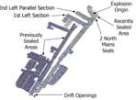
NIOSH Will Measure Atmospheres of Sealed Areas
NIOSH asked coal mining companies yesterday to provide a list of mine sites where the agency can conduct studies on the composition of atmospheres within sealed areas. This research will test whether potentially explosive methane mixtures are present in those areas, how gas concentration changes over time and is affected by barometric pressure changes, and whether methane layering exists. The composition of atmospheres behind seals inside coal mines became a focal point after the Jan. 2, 2006, Sago Mine explosion in West Virginia in which 12 miners died.
MSHA's single source page on Sago is available here, and its conclusion that lightning triggered the Sago blast is here. Sandia National Laboratories' April 2007 report ("Measurement and Modeling of Transfer Functions for Lightning Coupling into the Sago Mine") on its test of the hypothesis that a lighting stroke caused the methane blast is available here.
Many resources about Sago and sealed areas are available at www.msha.gov. The agency last Friday launched a new Web server and a more powerful search tool for users.
NIOSH wants to sequentially test three or four underground coal mines of at least one square mile that produce medium to high volumes of methane. To be accepted, a mine site must be installing 120 psi seals that meet the current design standard. NIOSH asked companies to send letters of interest within 90 days to R.G. Gurtunca, Ph.D., NIOSH Pittsburgh Research Laboratory, 626 Cochrans Mill Road, P.O. Box 18070, Pittsburgh, PA 15236 (phone 412-386-6601, e-mail [email protected]). Either longwall or room-and-pillar mines are acceptable, and a soon-to-be-abandoned coal mine is an option, it said.